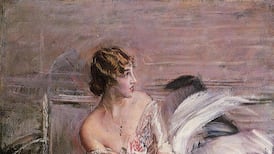When the music collector Edward Bunting chronicled a revival of the Gaelic harp in the 1790s, one of the mysteries connected with the ancient instrument was a pair of strings in the middle known in English as the "sisters". They were tuned to precisely the same note, interrupting the diatonic run of the other strings. But nobody could explain why, not even the players – ancient themselves in some cases – who were rounded up for the Belfast Harp Festival of 1792. It was just one of those things: a tradition.
The Irish name for the strings was more telling, however, and suggests “sisters” was a bad translation. As the “comhluighe” strings, which means “lying together”, they take on a sexual connotation. And this was probably deliberate.
Modern harp scholars believe sexuality is a key to understanding the old instrument, as is the realisation that in Gaelic Ireland, the right and left-hand sides of anything were symbolic of male and female, respectively.
Men sat to the right of a fireplace, traditionally, women to the left. The same arrangement applied in churches.
Similarly, the bass notes of the Gaelic harp were plucked with the right hand, while the left played the higher range.
But as they merged, like yin and yang, they achieved perfect balance in the comhluighe strings, as equal partners.
This is among the revelations of a new book called The Trinity College Harp, by Brian Manners, subtitled – with less exaggeration that you might at first suspect – "Ireland and the most exotic music instrument in the world".
You may know the instrument better as the Brian Boru harp (a misnomer, because it dates from the 1400s). And you certainly know it, even if you have never visited Trinity's Long Room, where it resides.
It’s the harp that provided the model for both the State symbol of Ireland and, facing the other way, the logo of Guinness.
But for all its great fame, you have almost certainly never heard it, nor any harp of its kind, played, because the modern Irish lookalike – invented barely a century ago by John Egan – sounds nothing like it.
In fact, the Trinity Harp was played as recently as the 1960s.
Being 600 years old, unfortunately, it found the experience traumatic. As the metal strings were twanged by fingernails, old-style, cracks appeared in the soundbox.
So the experiment is unlikely to be repeated. And anyway, once was enough to be revelatory. An English musicologist who was present called the sound “rich and resonant, with something of both bells and guitar”. But you had to be there. The poor-quality recordings that still exist remind Manners of “a battered piano in a saloon in the Wild West”. Readers of the book can judge themselves. A sample is among a number of digital audio extracts embedded in the text, accessible by phone app.
The delicacy of the Trinity harp is one of the reasons it remains mysterious. Its soundbox, or in Irish com (belly), cannot be opened. But a CT scan of another ancient harp, the Queen Mary in Scotland, has revealed small furrows cut inside the soundbox, presumably for acoustic enhancement.
Studies there also suggest that the subdued brown tones of the Trinity instrument, as seen now, may be a travesty of the original. Traces of vermilion – a dye of similar extravagance to gold leaf in medieval times – have been found on the Queen Mary. So Manners suspects the typical Gaelic harp may have been “a riot of psychedelic colours”.
Such details apart, his book also uses the Trinity harp has a gateway to the history of Gaelic Ireland in general, by way of explaining why the instrument was important enough to bequeath itself, uniquely in the world, as a national symbol.
And getting back to the “comhluighe” strings, the history contains an irony in that the old Gaelic harp was usually played by men, whereas the modern instrument is almost exclusively a female preserve.
There doesn’t seem to have been any cross-over where the two coexisted. By some accounts, the old tradition went out with the 1790s generation, although a footnote in Manners’s book suggests that the “very last” true Gaelic harper may have been Pádraig Dall Ó Beirne, who died in 1863.
I'm partial to the latter theory, because that Blind Patrick Byrne appears to have been my great-great granduncle. But in any case, the book also lists the other old harp-string names Bunting recorded. And it seems poignant to note that, near the "male" end of the range, was one called the "fallen string".











